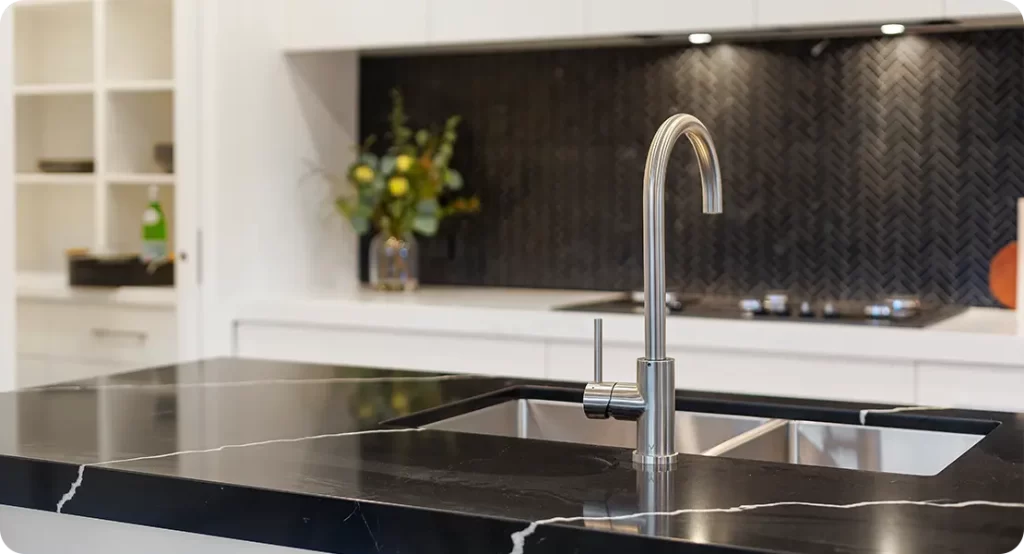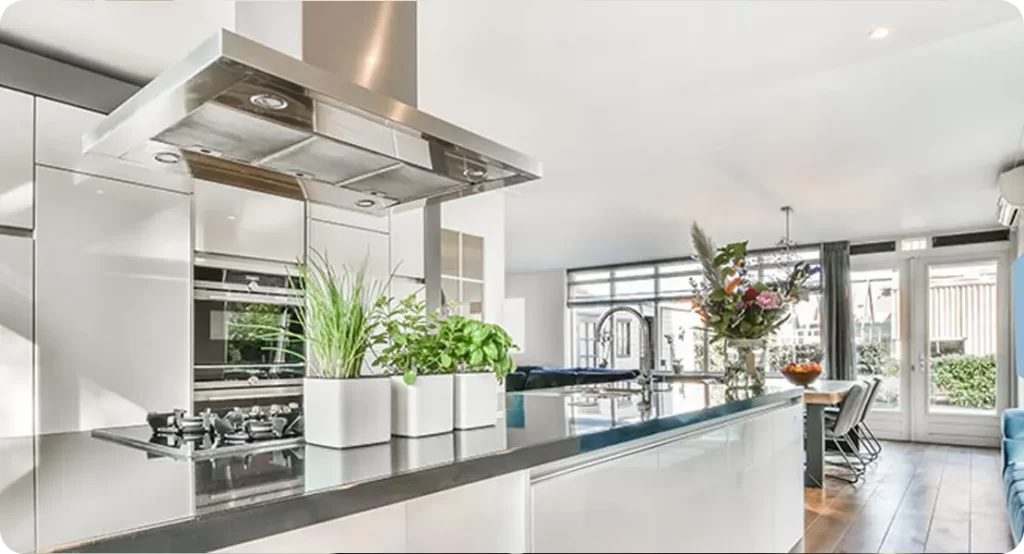Thinking about giving your kitchen a makeover? You’re not alone. In London, where property prices are at a premium, a well-designed kitchen can do more than just make your home look good—it can add serious value.
But before you start picking out marble worktops and statement taps, it’s worth understanding how to get the best return on your investment. Let’s walk through everything you need to know to add value to your London home with a kitchen renovation—smartly and strategically.
1. Know Your Local Property Market
First things first—what’s the ceiling price in your area? There’s no point in spending £50,000 on a kitchen if homes in your neighbourhood cap out at a certain value. Use tools like Zoopla, Rightmove, or the Land Registry to check sold prices nearby, and speak to local estate agents who understand what buyers are looking for in your postcode. They’ll be able to tell you what types of renovations are actually influencing sale prices—and which are purely cosmetic.
In many parts of London, especially Zones 2 and 3, a stylish, functional kitchen can seriously boost your home’s appeal. These areas are often sought after by young professionals and families who value practical upgrades that improve day-to-day living. A well-planned kitchen can be the tipping point that helps your home sell faster—or even spark a bidding war.

However, it’s important to tailor your renovation plans to the expectations of your local buyer profile. In more upmarket areas like Kensington, Hampstead, or parts of Chelsea, buyers often expect premium finishes, high-spec appliances, and even bespoke joinery. If your home sits in a high-value market, skimping on quality could end up hurting your property’s perceived value.
On the flip side, in more affordable neighbourhoods or developing boroughs like Barking, Croydon, or Newham, practicality and modernisation can go a long way. Buyers might prioritise clean finishes, energy-efficient appliances, and multifunctional layouts over luxury extras.
Also, think about the type of property you own. A kitchen renovation in a studio flat won’t add the same value as one in a family-sized Victorian terrace—but it might make your property stand out in a crowded rental market. Ultimately, knowing your market ensures you invest wisely and renovate with purpose—not just personal preference.
2. Choose a Layout That Works
Open-plan living is still incredibly popular in London, especially in period conversions and smaller terrace houses where space is tight. Knocking down a wall to create a kitchen-diner or kitchen-living area could make the whole property feel larger and brighter—two things buyers love.
However, if you’re working with a compact space, think smart instead. L-shaped or galley kitchens can be just as effective with clever storage solutions and a well-thought-out flow. Don’t underestimate how powerful a “wow” factor can be in small homes.
Here are the main types of kitchen layouts, along with notes on how they can add value to a London home:
- L-Shaped Kitchen
Description: Cabinets and appliances run along two adjacent walls.
Value Potential: Efficient for smaller or medium-sized homes; great for open-plan designs. Maximises corner space and suits family living.
Best For: Flats, Victorian terraces, and semi-detached homes. - U-Shaped Kitchen
Description: Units on three walls, forming a “U” shape.
Value Potential: Offers plenty of worktop and storage space, especially valued in larger family homes. Can feel enclosed if not well-lit.
Best For: Wider rooms, detached homes, or homes where entertaining is key. - Galley Kitchen
Description: Long and narrow layout with cabinets on both sides.
Value Potential: Makes great use of limited space, especially in older London townhouses or converted flats. Buyers appreciate smart storage and ergonomic design here.
Best For: Narrow kitchens, small flats, or period properties. - Island Kitchen
Description: Central island added to L- or U-shaped layouts.
Value Potential: Big crowd-pleaser. Islands add workspace, storage, and social appeal. Highly desirable in open-plan homes.
Best For: Modern builds, larger homes, and open-plan conversions. - Peninsula Kitchen
Description: Similar to an island, but connected to a wall or unit.
Value Potential: Offers some benefits of an island in tighter spaces. Great for breakfast bars and informal dining.
Best For: Medium-sized homes or where space doesn’t allow a full island. - Single-Wall Kitchen
Description: All units placed along one wall.
Value Potential: Ideal for studios and compact flats. While limited in workspace, it can look sleek and modern. Adds value if designed with high-quality finishes and efficient storage.
Best For: Open-plan studios or new-builds with limited square footage.
3. Invest in the Right Features
It’s easy to get carried away with Pinterest boards and Instagram inspiration, but remember: not every trend will stand the test of time—or appeal to everyone.

Here are some features that add real value to your kitchen renovation:
- Quality Appliances
When it comes to kitchen appliances, buyers are increasingly drawn to integrated, energy-efficient models. Brands like Bosch, NEFF, and Miele are known for reliability and performance, and they signal a quality-first renovation to potential buyers. Integrated appliances offer a seamless, minimalist look—perfect for modern London homes where space and style both matter.
Features like a self-cleaning oven, an induction hob with touch controls, or a smart fridge that connects to your phone aren’t just luxurious—they’re practical. They make daily tasks easier and more enjoyable. Smart tech is especially popular among younger buyers and professionals looking for “future-proof” homes. - Durable Worktops
Worktops take a beating—whether it’s knife scratches, hot pans, or spilled red wine. That’s why choosing the right surface matters. Quartz is a standout option: it’s sleek, durable, non-porous, and available in a huge range of colours and patterns. Granite offers natural beauty and strength, while newer composite materials balance affordability with high-end appeal.
These surfaces are not only low-maintenance but also help create a premium feel. Buyers don’t want to worry about chipping laminate or stained wood—they want reassurance that the kitchen will stay looking great for years to come. - Smart Storage
Clutter is the enemy of a beautiful kitchen. Today’s buyers want clever, concealed storage solutions that make the space feel bigger and more functional. Pull-out larders provide excellent access to everyday pantry items without wasting vertical space. Corner carousels and LeMans units turn dead corners into useful storage, while deep drawers offer easier access than traditional cupboards.
Integrating bins, spice racks, or even plug sockets into cabinetry shows thoughtful design—and that kind of detail stands out during property viewings. In compact London homes, making the most of every inch is a must. - Lighting
Never underestimate the power of good lighting. A well-lit kitchen feels more inviting, more luxurious, and—importantly—more spacious. Layered lighting is key: - Ambient lighting (ceiling fixtures or downlights) provides overall illumination.
- Task lighting (under-cabinet lights or pendants over worktops) makes food prep easier and safer.
- Accent lighting (LED strips in shelving or toe-kicks) adds a designer touch and enhances atmosphere.
Dimmable LEDs or smart lighting systems that adjust colour temperature based on time of day are becoming increasingly popular. They don’t just boost style—they boost the home’s perceived value.
Avoid anything too polarising—lime green cabinets or overly industrial finishes might turn off some buyers, no matter how on-trend they seem now.
4. Go Energy-Efficient
Energy performance is becoming increasingly important, especially in older London homes. Incorporating energy-saving features into your kitchen can boost your home’s EPC rating and future-proof your property.

Think about:
- LED Lighting
LED lights use significantly less energy than traditional bulbs and have a much longer lifespan. They’re also available in various styles and colour temperatures, so you can enhance your kitchen’s ambiance while cutting electricity costs. - Energy Star-Rated Appliances
These appliances are designed to consume less water and electricity, which is a major plus for cost-conscious and eco-minded buyers. A-rated ovens, fridges, and dishwashers can be key decision-makers during viewings. - Improved Insulation Behind Units
Adding insulation behind cabinets—especially those on external walls—can reduce heat loss and improve your home’s overall energy efficiency. It’s a hidden upgrade that boosts comfort and saves money in the long run. - Water-Saving Taps
Aerated or sensor taps limit water flow without compromising performance. This is especially appealing in London, where water metering is becoming more common and sustainability is top of mind.
Buyers are more conscious than ever of utility bills and environmental impact. Highlighting these upgrades can be a subtle but powerful selling point—often setting your home apart in a competitive market.
5. Don’t Forget the Finishing Touches
Details matter. Even if your budget doesn’t stretch to a full renovation, a cosmetic refresh can still increase your home’s value. Here are a few quick wins:
- Repaint Tired Cabinets
A fresh coat of paint can instantly lift the look of worn cabinetry. Choose timeless neutrals like soft greys, warm whites, or sage green to appeal to a broad range of buyers. - Replace Old Handles with Modern Hardware
Swapping out dated or tarnished handles is one of the easiest ways to modernise a kitchen. Sleek bar handles, matte black pulls, or brass knobs can give your units an instant style update. - Update the Splashback with Stylish Tiles
A new splashback can add a bold design statement or a subtle modern touch, depending on your choice. Consider classic metro tiles, herringbone patterns, or textured finishes to add interest without overwhelming the space. - Swap Outdated Taps for Sleek, Brushed Metal Fixtures
Upgrading to a modern tap in brushed nickel, matte black, or brass can completely change the vibe of your sink area. Look for styles with pull-out nozzles or single-lever mixers to add both style and function.
These small tweaks can make an old kitchen feel new again—and they make a big impression during viewings. Often, buyers won’t notice exactly what changed—just that the space feels fresh, modern, and ready to move into.
6. Plan Your Budget—and Stick to It
A kitchen renovation in London can range from £8,000 for a modest update to £30,000+ for a high-end redesign. Be honest about your goals and plan accordingly. If the aim is to increase your home’s value, you don’t want to overspend and lose your return. Always consider your property’s ceiling price and the local market—your kitchen investment should be proportionate to your home’s overall worth.
Set aside a contingency fund of around 10–15% for unexpected costs (because they will come up), and always get multiple quotes from trusted tradespeople. Labour costs in London can vary widely, and a detailed quote helps you avoid unpleasant surprises. Make sure you’re comparing like-for-like when reviewing quotes—check whether materials, waste removal, and aftercare are included.

If you’re in a flat, check if you need freeholder consent before starting structural work. Some renovations, particularly if they involve plumbing or load-bearing changes, may also require building control approval or even a party wall agreement. Overlooking these steps can result in costly delays.
Lastly, prioritise where your money goes. Splurge on features that matter most to buyers—like appliances and worktops—but be smart about savings on fixtures or DIY-friendly tasks like painting. A well-planned budget keeps your project on track and your investment working for you.
7. Work with a Designer (Even Briefly)
Even if you’re planning to manage the project yourself, a short consultation with a kitchen designer can be worth its weight in gold. They’ll spot layout problems, suggest space-saving solutions, and help you make decisions that boost resale value—not just personal taste.
Many London kitchen companies offer free design consultations, so take advantage. A fresh pair of eyes can help you avoid costly mistakes and maximise every inch of space.
Designers are trained to see the big picture while paying close attention to detail. They can help you plan lighting schemes, workflow efficiency (like the “kitchen triangle”), and clever storage without compromising on style. They’re also familiar with the latest trends and materials, so you can blend modern appeal with timeless value—ideal if you’re renovating to sell in the near future.
In compact London homes, space is often the biggest challenge. A designer can suggest multi-functional features like breakfast bars that double as prep stations, or integrated seating to save square footage. They also tend to have industry connections, which could lead to discounts on cabinetry, appliances, or fittings.
Ultimately, working with a designer—even briefly—can help you approach your renovation with more clarity, more creativity, and far fewer regrets.
8. Think About Lifestyle Appeal
In a fast-paced city like London, buyers often look for homes that make life easier and more enjoyable. A well-planned kitchen that supports a busy lifestyle—quick meals, entertaining friends, family dinners, or even remote working—will resonate far more than a showpiece that lacks day-to-day functionality. The modern buyer doesn’t just want a kitchen that looks great in photos; they want one that works with their real-life routines.
Here’s what helps:
- A breakfast bar or island for casual dining
This creates a social hub where people can eat, chat, or work without crowding the cooking area. It’s especially popular in open-plan living spaces and family homes. - Easy-clean surfaces and floors
Materials like quartz worktops, gloss-finish cabinets, and vinyl or tiled flooring are both stylish and practical. They reduce maintenance and keep the kitchen looking fresh with minimal effort—perfect for busy households. - Space for a coffee machine or wine fridge (yes, really)
Small luxuries go a long way. A designated coffee corner or a built-in wine cooler can elevate the kitchen experience and add a boutique feel that impresses buyers. - Seamless indoor-outdoor access, if you have a garden or terrace
Bi-fold or sliding glass doors can create a flow between kitchen and garden, ideal for summer entertaining. Even a compact balcony can be a selling point when it’s integrated thoughtfully.
Buyers want to imagine themselves living in the space—not just admiring it. Make your kitchen look like the heart of the home, and a future buyer will likely fall in love with the entire property.

Final Thoughts
A kitchen renovation is one of the smartest ways to add value to your London home—but only when it’s done right. Stay in tune with your area’s property trends, focus on practical yet beautiful design, and keep your target buyer in mind at every step. Remember, it’s not just about what looks good—it’s about what works and sells.
Done well, your new kitchen could not only transform how you live day-to-day, but also give you a solid return when it’s time to sell. It can increase buyer interest, reduce time on the market, and even attract higher offers. Small, strategic choices often make the biggest impact—so don’t overlook the power of smart storage, energy efficiency, and lifestyle appeal.
Whether you’re planning to sell in the near future or simply want to future-proof your space, investing in your kitchen is rarely a decision you’ll regret. With the right planning and execution, it can become the heart of your home—and one of its most valuable assets. Now, that’s a renovation worth investing in. If you’re considering a home extension, feel free to contact us at Eton Builders in London for a free consultation with our expert team.

